


 Congressional Notebook
Congressional Notebook
|
 RMRS Publications
RMRS Publications
|
 Experimental Forests
Experimental Forests
|
 Partnerships
Partnerships
|
 US Forest Service Links
US Forest Service Links
|
 RMRS Archives
RMRS Archives
|
|
|


|
|
Home > About RMRS > RetrospectiveA Retrospective Look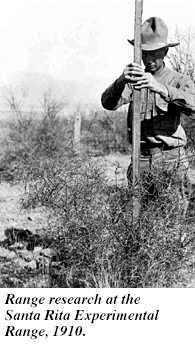
The Rocky Mountain Research Station's 14-state territory, extending from Canada to Mexico, and Nevada to the Great Plains, is home to some of the first forest and rangeland research sites in the Nation. The oldest, Santa Rita Range Reserve, was established in 1903 near Tucson, Arizona. Initially assigned to the Bureau of Plant Industry, it was transferred to the Forest Service in 1915 and called an experimental range. Today, it still serves as a center of study of the vast semidesert ranges of the Southwest. In 1908, the Forest Service began its formal timber management research at the Fort Valley Experimental Forest near Flagstaff, Arizona. Shortly thereafter, in 1909, the Fremont Experimental Station was founded near Manitou Springs, Colorado, with studies focused on Engelman spruce, ponderosa pine, and Douglas-fir. In 1911, the Wagon Wheel Gap Experimental Watershed, also in central Colorado, was established to study streamflow and erosion. Also in 1911, and further north, the Priest River Experimental Forest began operations in Idaho's northern panhandle. Researchers studied thinning, planting, regeneration, and exotic tree species. The Jornada Experimental Range also was founded that year in southern New Mexico, with a mission to sustain and improve rangelands, and work began at the Utah Experiment Station, high on the slopes of the Wasatch Plateau in central Utah, where scientists studied silviculture and mountain rangelands. During this period of seemingly rapid growth, experiment stations bore little resemblance to the stations of today in terms of size, scope, administrative independence, and sophistication of research. The stations were small in both staffing and funding, and were administratively part of a district (now known as a National Forest Service Region). Research direction came from the Forest Service Chief's office in Washington, D.C. and the regional forester's office. The early stations, in size and organization, resembled experimental forests within a national forest, rather than the system of laboratories found in urban settings today. Passage of the McSweeney-McNary Act of 1928 gave research a recognized separation from national forest administration. It provided for the establishment of a network of 12 regional experiment stations that would be the backbone of Forest Service research. Four experiment stations would eventually be located throughout the Interior West: the Northern Station in Missoula, Montana; the Intermountain Station in Ogden, Utah; the Southwestern Station in Tucson, Arizona; and the Rocky Mountain Station in Fort Collins, Colorado. By the 1950's, reduced budgets were resulting in a declining research program, especially at the smaller western facilities. In 1953, to help meet changing needs, USDA announced a series of significant reorganizations, including the mergers of the Northern and Intermountain Stations (headquartered in Ogden), and the Southwestern and Rocky Mountain Stations (headquartered in Fort Collins). Over the next four decades, the two stations formed and reformed their research programs to meet the ever-evolving needs of natural resource management in the Interior West. Population growth, coupled with the public's increasing interest in land management activities, intensified the need to help resource managers and planners balance economic and environmental demands for forest and rangeland resources. In May 1997, the Intermountain Research Station and the Rocky Mountain Forest and Range Experiment Station merged into the Rocky Mountain Research Station (RMRS), headquartered in Fort Collins, Colorado. The following two articles present individual histories of the former Intermountain and Rocky Mountain Research Stations. A Historic Look at the Intermountain Research
Station There was no organization known as the Intermountain Station until 1928, but its origins can be traced to earlier times. Just as the current Rocky Mountain Research Station is the product of station consolidation, so was the Intermountain Station. The former station's genesis goes to two locales: 1) Priest River Experimental Forest in Idaho's panhandle, and 2) the Utah Experiment Station in Utah. The organizational evolution at Priest River led to the formation of the Northern Rocky Mountain Station, and at Ephraim, Utah, to the Intermountain Station. The two were combined in 1953 under the name Intermountain Forest and Range Experiment Station. 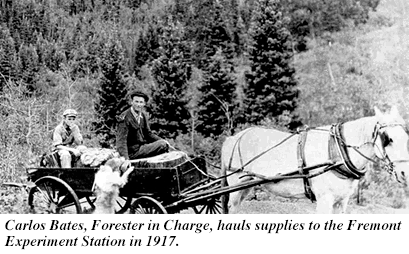
Research at Priest River began on September 1, 1911, and, to the south, in 1912, construction of the Utah Experiment Station was begun on the slopes of the Wasatch Plateau in central Utah. Priest River and the Northern Rocky Mountain Station Priest River scientists carried out silvicultural and forest products utilization studies and developed an appreciation of indirect forest benefits. The initial concept for the development of Priest River was to create a miniature (4,500 acres) model forest managed along European lines. It was to be financially self-supporting from the sale of timber. The model forest concept never fully developed, however, because there was no steady, local market for timber. The poor transportation network and distance from sawmills worked against the scheme. Millions of acres of timber land in northern Idaho and western Montana were burned in the disastrous fires of 1910. Consequently, the earliest work at Priest River emphasized planting and methods of cutting. Forest fire research studies began in 1916, the year Priest River headquarters moved to Missoula, Montana, because it was the site of Forest Service Region 1 headquarters. At one point, limitations on staffing and research funds reduced the Station to J.A. Larsen, who served as both the station director and lone investigator. By 1922, Harry Gisborne, recognized by many as the "father of forest fire research," became the first full-time forester assigned to Priest River. Total Station funding reached $18,920 in 1923 to accommodate the new fire research activity. From its inception, the Station was known by a hodgepodge of different names. Repeated requests were made to Washington, D.C. to change the name to the Northern Rocky Mountain Station, since headquarters was in Montana, not Idaho. The requests were to no avail until 1925 when the name change was approved. In 1925, Bob Marshall, the now well-known proponent of wilderness, joined the Station. Today, he is recognized as one of the founders of the national forest wilderness system. Western white or Idaho white pine was the premier timber species in the Station's territory, and much of the research program was related to that species. The introduced disease white pine blister rust was the focus of much research and control activity. In later years, it was conceded by most, that employment in control measures aided paying the college tuition for many forestry school students, but didn't help much in inhibiting the spread and destruction of the rust. Utah Experiment Station At the turn of the century, central Utah was the locale for heavy sheep grazing, typical of a number of areas in the Intermountain West. By the early 1900's, overgrazing in the mountain ranges resulted in devastating floods coming out of the canyons along the Wasatch Plateau and Wasatch Front. The floods caused great and repeated damage to communities located in the valleys and at mouths of canyons. It was this flooding that provided the impetus for establishing the Utah Experiment Station in Ephraim in 1912. At the time, range research in the Forest Service was a function of the Branch of Grazing, and not the Branch of Research. Thus, the initiation and direction of the Utah Experiment Station was different that that of the other research stations. Since heavy snows limited the use of the site to the period of late spring to early fall, the staff moved to Ogden for the remainder of the year, and construction did not begin until 1913. Arthur Sampson served as the first station director until 1922. After a few years of operation under the name Utah Experiment Station, the name was changed to the Great Basin Experiment Station. 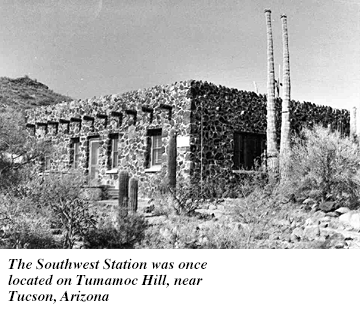
Again, to illustrate the minuscule size of the stations in the early 1920's, the Great Basin staff consisted of the director, two temporary field assistants, and a newly-acquired light Ford truck. By 1924, Station Director Clarence Forsling found himself alone as the sole Station employee. Early research at the Station was directed range seeding, silviculture of aspen, lodgepole pine, ponderosa pine, and the management of mountain ranges to control erosion and flooding. McSweeney-McNary Act of 1928 Passage of the McSweeney-McNary Act of 1928 gave research a recognized separation from national forest administration. It provided for the establishment of the Intermountain Station, but did so with less precision than for the Northern Rocky Mountain and the other 10 forest and range experiment stations. The Act authorized an additional station for Utah and adjoining states, but brought no overnight transformation. The promise of a brighter day for Forest Service research funding was dampened by the stock market crash of 1929 and the following Great Depression - lasting from the early 1930's to WWII. Intermountain and Northern Rocky Mountain Stations Merge USDA announced a series of significant reorganizations in 1953 that affected the Forest Service. Among the changes was the merger of the two stations on January 1, 1954. Territory for the new Intermountain Station included northwestern South Dakota, eastern Washington, and a bit of eastern California, in addition to the territory covered at the time of the recent merger with the Rocky Mountain Station. One of the many questions faced in the merger was where to locate Station headquarters - Missoula or Ogden? Reed Bailey, Intermountain Station Director at the time, was near the end of his career and not in the best of health. He was supposed to go to Berkeley, California to head up the California Forest and Range Experiment Station, but decided he didn't want to go. He also decided he didn't want to go to Missoula, so, at a meeting of Station personnel in Missoula, he announced that headquarters would remain in Ogden. The shock of the Russian launch of Sputnik in 1958 opened the coffers of the federal treasury to support science and research. While forestry research wasn't a high national priority, the programs grew nonetheless. The period of the late 1950's to the early 1970's was the "Golden Era" with respect to the growth of Forest Service research programs in terms of laboratory construction, equipment purchases, increased staffing, and operating money. Merger of the Rocky Mountain and Intermountain Stations In 1992, USDA was taking a lot of criticism as being not only wasteful, but out of control. Critics claimed there were too many agencies and too many employees within the Department. The criticism wasn't directed at the Forest Service, but as a component agency, it was not immune from being part of the Department's reaction. 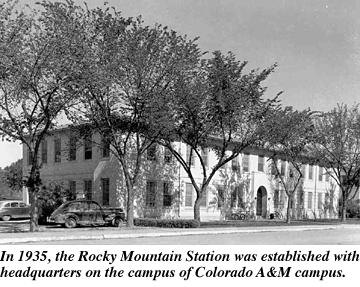
With a presidential election coming up in the fall, Agriculture Secretary Edward Madigan asked all agency heads to seek greater efficiencies of operation. With the station directors of both the Intermountain and Southern Stations recently retired, and their positions unfilled, in August 1992, Forest Service Chief Dale Robertson proposed merging the Intermountain with the Rocky Mountain Station, and the Southern with the Southeastern Station. Shortly thereafter, a change in Administrations occurred with the election of Bill Clinton as President, and Secretary Madigan was replaced by Secretary Espy. Before the proposed mergers could take place, Vice President Al Gore led an initiative to "reinvent government." As part of that effort, the Forest Service developed a plan for a major organizational restructuring, and the station mergers were put on hold. Finally, in May of 1997, nearly 5 years after first proposed, the Rocky Mountain and Intermountain Stations were merged. A Historic Look at the Rocky Mountain Forest and Range Experiment Station The history of natural resources research in the Central and Southern Rockies dates back to the early part of the century when the Santa Rita Range Reserve was established in 1903 near Tucson, Arizona. It was a center of study of the vast semi desert ranges of the Southwest. In August 1908, the Forest Service began its formal timber management research with establishment of the Fort Valley Experimental Forest near Flagstaff, Arizona. The first research endeavors in what is now Region 2 of the Forest Service was the Fremont Experiment Station, begun in 1909 near Manitou Springs, Colorado. In those days the automobile was a luxury and forest administrators were not thinking in terms of highway accessibility, so access to the facility was by tram, with horse and wagon between the upper terminal and the headquarters. Here, the principal forest types of the region, Engelmann Spruce, ponderosa pine, and Douglas-fir, were studied. A milestone in watershed management investigations began in 1911 with the establishment of the Wagon Wheel Gap Experiment on the Rio Grande National Forest in Colorado. Focus was on the effects of forest cover on streamflow and erosion. Also in 1911, the Jornada Range Reserve was founded in southern New Mexico. It's objectives were similar to those of Santa Rita - how to improve and maintain rangelands, and how to manage for sustained use and production of range livestock. In 1915, the Forest Service established the Branch of Research. The activities of the forest experiment stations, the Forest Products Lab in Madison, Wisconsin, and the Washington, D.C. Office of Products and Silviculture were placed under this new Branch of Research. Included were experimental sites in the Central and Southern Rockies, namely Fort Valley, Fremont, and Wagon Wheel Gap. Santa Rita and Jornada Range Reserves continued under the Washington Office of Grazing Studies until 1926 when they also became part of the Branch of Research. 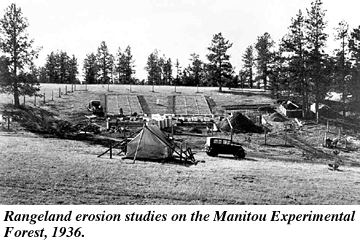
As the importance and use of forest land resources further increased, the Forest Service recommended the creation of a nationwide forest research program consisting of one forest experiment station for each of the 12 major timber regions of the United States. Under the McSweeney-McNary Act of 1928, Congress appropriated funds for establishment of the Southwestern Forest and Range Experiment Station in 1930 on the University of Arizona campus in Tucson. The Station's territory included Arizona, New Mexico, west Texas and the Oklahoma panhandle. Research focused on timber, watershed, and range management. The Station was later relocated to Tumamoc Hill, 3 miles west of the city. The Rocky Mountain Forest and Range Experiment Station, the last of the 12 stations funded, was established in 1935 on the Colorado College of Agriculture and Mechanical Arts campus (now Colorado State University) in Fort Collins. All research previously handled by the Forest Service in the central Rockies, including Fremont, was absorbed by the new Station. R.E. McArdle, who later became Chief of the Forest Service, was the first Station Director. In 1936, the Manitou Experimental Forest was established near Woodland Park, Colorado to conduct watershed management studies. The Fraser Experimental Forest began operations in 1937 near the town of Fraser, Colorado. This 36-square-mile outdoor laboratory was selected to study pressing problems related to water yield from high-elevation forests and alpine areas. Finally, the Central Plains Experimental Range was founded in 1939 on the eastern plains of Colorado to study range management and grazing. (It was transferred to the Agriculture Research Service in 1954). In 1953, the Rocky Mountain and Southwestern Stations joined forces and merged, with headquarters in Fort Collins because it was considered a more central location with available library and research facilities at Colorado A&M College. During the 1960's and 1970's, several new laboratories were built throughout the Station's territory: Rapid City, SD and Tucson, AZ in 1960; Flagstaff, AZ, Laramie, WY, and Bottineau, ND in 1963; Tempe, AZ in 1965; a new headquarters building was constructed in 1967; the Albuquerque lab was co-located with the Forest Service's Southwest Regional Office in 1967; and the Lincoln, NE lab was dedicated in 1973. Today, the Rocky Mountain Research Station is home to nearly 400 scientists, administrators, and support personnel. The Station administers and conducts research on 14 experimental forests, ranges, and watersheds, and maintains long-term ecological data bases for these areas. It also oversees activities on more than 200 research natural areas, and has the lead in five partnership ecosystem management and research projects in Arizona, Colorado, Montana, New Mexico, and Nevada. |
Rocky Mountain Research Station
Last Modified: Monday, 28 April 2008 at 17:12:34 EDT (Version 1.0.5)

